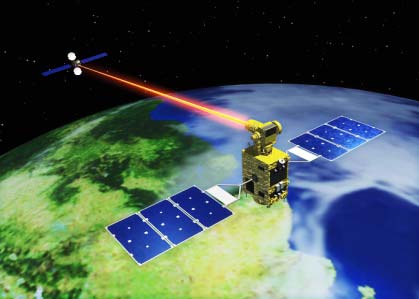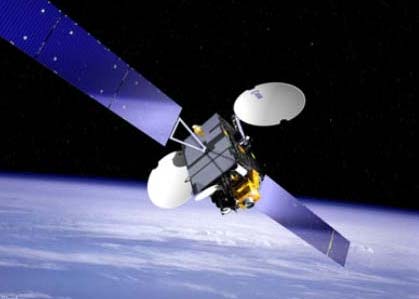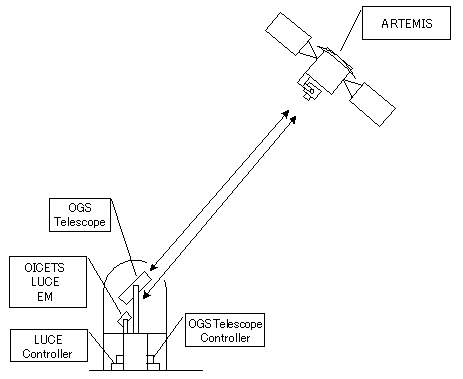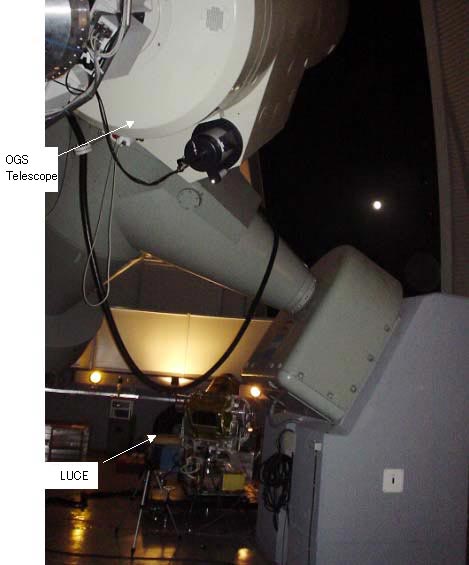Communication Experiment Using Optical Inter-Orbit Communication Equipment Aboard OICETS
National Space Development Agency of Japan
The National Space Development Agency of Japan (NASDA) conducted an optical communication experiment for data transmission/acquisition from September 9 to 14, 2003 (Japan Standard Time: hereinafter referred to as JST) between a engineering model (the same as the flight model) of the Optical Inter-orbit Communications Engineering Test Satellite (OICET) and the Advanced Relay and Technology Mission (ARTEMIS) of the European Space Agency (ESA) now in orbit, and got a successful result.
This experiment was to confirm pre-launch optical adaptability of OICETS with ARTEMIS by conducting two-way optical communications between ARTEMIS now in geostationary orbit and an optical communication equipment engineering model, which was installed at ESA's Optical Ground Station (OGS) located in Tenerife Island of the Spanish territory's Canarias Islands in the Atlantic Ocean.
The successful result of this experiment verified the adaptability of optical equipment of two satellites, which was one of the important pre-launch verification items for OICETS.
OICETS is a satellite to pursue orbital verification of element technologies, such as acquisition/tracking/pointing technologies between ARTEMIS in geostationary orbit and OICETS in low earth orbit (LEO) under international cooperation. This optical inter-orbit communication technology is important for future space activities in terms of large-volume communication and miniaturized on-board equipment. OICET is scheduled for launch in FY 2005.
|
|
About OICETS
The Optical Inter-orbit Communications Engineering Test Satellite (OICETS) is to make orbital verification of element technologies centering on acquisition, tracking, and pointing technologies between ARTEMIS in geostationary orbit and OICETS in low earth orbit (LEO) in the context of optical inter-satellite communications which will be essential for future space activity.
The optical communication experiment between ARTEMIS and OICES is the international colaboration with ESA., and is under preparation for launch in 2005.

Image Picture of OICETS in Orbit
| Shape | Main Body: 0.78 m x 1.1 m x 1.5 m (height) Total Height including Optical Antenna: 2.93 m Total Length including Solar Array Paddle: 9.36 m |
|---|---|
| Mass | Approx. 570 kg at launch |
| Orbit | Circular Orbit (Altitude: 610-550 km, Orbit Inclination: Approx. 35 degrees) |
| Mission Duration | 1 year |
| Mission | Orbital Experiments of Element Technologies Centering on Inter-Orbit Acquisition and Tracking using Optical Subsystem. Optical Semiconductor Device and Space Demonstration of Optical Technology |
About ARTEMIS
The Advanced Relay and Technology Mission (ARTEMIS) of the European Space Agency (ESA) is to conduct advanced inter-orbit communication experiments, land mobile communication experiments and so on.
ARTEMIS was launched aboard Ariane 5 on July 12, 2001, but was failed to place into geostationary orbit due to a malfunction in its second stage. A year-and-half operation using the electrical propulsion device for orbit control made a successful completion of transferring ARTEMIS into geostationary orbit on January 31, 2003.
In late March 2003, ARTEMIS had the successful intersatellite communication experiment using microwave with NASDA's Advanced Earth Observing Satellite II (ADEOS-II), "Midori II".

Image Picture of ARTEMIS in Orbit
| Shape | 25 m x 8 m x 4.8 m (when deploying an antenna) |
|---|---|
| Mass | 3.1 ton at launch |
| Orbit | Geostationary orbit (at east longitude of 21.5 degrees) |
| Mission Duration | 10 years (5 years for optical communication equipment) |
| Mission | Optical Communications Data Relay (S / Ka band) Land Mobile Communications (L band) |
Outline of Optical Adaptability Test between the Engineering Model of Optical Inter-Orbit Communication Equipment and ARTEMIS
1. Purpose
In order to make a smooth implementation of orbital experiments between OICETS and ARTEMIS, a prior test to verify the adaptability between these two satellites' optical inter-orbit communication equipment will be conducted before the launch of OICETS. This test makes it possible to confirm the interface of optical communications at a pre-launch phase and minimizes risks associated with orbital experiments.
2. Implementation
ESA has an optical ground station (OGS) for periodic checkouts of the optical communication equipment aboard ARTEMIS located at an altitude of about 2,400 m of Mt. Teide in Tenerife Island of the Canarias Islands. The selection of OGS makes it possible to conduct an experiment, which controls the effects of atmospheric fluctuation.
By installing inside the OGS dome the engineering model of the Laser Utilizing Communications Equipment Engineering Model(LUCE EM) aboard OICETS, the test is to establish an optical link with ARTEMIS and to confirm the adaptability of two satellites.

Structure of Optical Adaptability Test between ARTEMIS and LUCE
LUCE is installed next to the OGS telescope in the OGS dome. By making ARTEMIS point toward OGS with strong laser beams emitted from the OGS telescope,
LUCE can make acquisition easier. LUCE is controlled at the control room under the dome room.
The picture shows LUCE beside the OGS telescope pointing toward ARTEMIS. A small point at the opening indicates the Moon. The experiment gradually decreases the level of laser beams emitted from the telescope, and finally turns over to communications between LUCE and ARTEMIS
